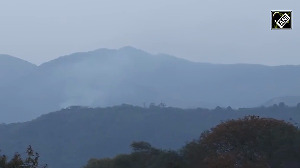Trademark of Shaivite Kashmir, Amarnath is expected to attract one lakh more pilgrims than 2005 during a two-month-long period from Sunday, Director, Public Relations Shri Amarnath Shrine Board Madan Mantoo told a visiting PTI correspondent in Sonamgarh.
A Trek to Lord Bholenath's Abode
"Our focus is to take measures for the preservation of nature in all forms," he said. For this, pre-fabricated rooms and toilets have come up all along the 46 km Pahalgam-Amarnath and Baltal cave routes, he said, adding that helipads too have been shifted from Amarnath cave to other places almost one and half km away from cave.
The yatra has never stopped ever since it started several centuries ago. Even during the peak of militancy in 1990, 1991, 1992 and 1993 it saw a steady rise in the number of pilgrims from 15,7000 to 36,007.
After that, there was a heavy increase in arrival of pilgrims to Amarnath. As many as 67,000 visited the shrine in 1994, 98,000 in 1995 and the number went upto 4.12 lakh in 2005.
Every year, a mass of humanity throngs the shrine to seek blessings from Lord Shiva's pair of doves. Legend has it that Shiva recounted to Parvati the secret of creation in a cave in Amarnath. Unknown to them, a pair of mating doves eavesdropped on the conversation. Having learnt the secret, they are reborn again and again and have made the cave their eternal abode. Many pilgrims report seeing the doves when they trek the arduous route to pay obeisance before the ice-lingam (the phallic symbol of Shiva), Shaivite scholar B L Pandita said.
At this incredible shrine, the image of Shiva, in the form of a lingam, is formed naturally of an ice-stalagmite, which waxes and wanes with the moon. By its side are, fascinatingly, two more ice-lingams, that of Parvati, and of their son, Ganesha, he said.
According to an ancient tale, there was once a Muslim shepherd named Buta Malik who was given a sack of coal by a sadhu (hermit). On reaching home, he discovered that the sack, in fact, contained gold, overjoyed and overcome, he rushed back to look for the sadhu and thank him, but on the spot of their meeting he found a cave.
Eventually this became a place of pilgrimage for all believers. To date, a percentage of the donations made by pilgrims are given to the descendants of Malik, and the remaining to the trust, which manages the shrine.
Yet another legend says that when Kashap Rishi drained the Kashmir valley of water (it was believed to have been a vast lake), the cave and the lingam were discovered by Bregish Rishi who was travelling across the Himalayas. When people heard of the lingam, Amarnath for them became Shiva's abode and a centre of pilgrimage.
The route to Amarnath is as difficult as it is exciting. Situated in a narrow gorge at the farther end of Lidder Valley, Amarnath stands at 3,888 meter and is 44.8 km from Pahalgam and 141 km from Srinagar.
Though the original pilgrimage subscribes that the yatra be undertaken from Srinagar, the more common practice is to begin the journey at Pahalgam, and cover the distance to Amarnath and back in five days. Pahalgam is 96 km from Srinagar. Since the base point for the pilgrim's trek is Pahalgam, a large makeshift township springs up to accommodate those undertaking the journey, Mantoo said.
"The conduct of the yatra is a gigantic task in which both civil and military departments join hands, the latter for providing medical facilities and helping to keep the route open," he said. All intermediate halting places have the same kind of facilities as provided at Pahalgam, and a yatra-officer is appointed to conduct the pilgrimage, he added.
The trek from Pahalgam to Amarnath cave is on an ancient peregrine route. The 45-km distance is covered in four days, with night halts at Chandanwari, Sheshnag (Wawjan) and Panchtarni. The distance from Pahalgam to Chandanwari (12.8 km) is covered in about five to six hours, and the trail runs along the Lidder river.
Pilgrims camp here on the first night out. A major attraction here is a bridge covered, year round, with ice even though the surroundings are free from it.
The next day's trek of 13 km, is through spectacular, primeval countryside and the main centre of attraction is Sheshnag, a mountain which derives its name from its seven peaks, resembling the heads of a mythical snake.
The journey to Sheshnag follows steep inclines up the right bank of a cascading stream and wild scenery untouched by civilisation. The second night's camp at Wawjan overlooks the deep blue waters of Sheshnag lake, and glaciers beyond it.
There are legends of love and revenge associated with Sheshnag, and at the camp these are recounted by campfires, to the stillness of a pine-scented Himalayan night. The third day's 13km trek steadily gains height, winding up across Mahagunas pass at 4,600 meter and then descending to the meadow-lands of Panchtarni, last camp enroute to the holy cave.
From Panchtarni to Amarnath is only 6 km, but an early morning's start is recommended for there is a long queue at the entrance to the cave. The same day, following darshan, devotees can return to Panchtarni in time for lunch, and continue to Wawjan to spend the fourth night out or continue further to Zojibal, returning to Pahalgam on the fifth day.
Entry to the cave is regulated and darshan a hasty affair for there are many others waiting outside. The devotees sing bhajans, chant incantations, and priests perform aarti and puja, invoking the blessings of Shiva.
"For those who journey with faith, it is a rewarding experience, this simple visitation to a cave shrine, the home of the Himalayan mendicant who is both destroyer and healer, the greatest of the Hindu gods," Pandita said.







 © 2025
© 2025